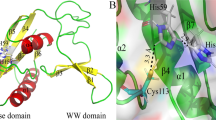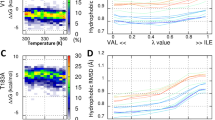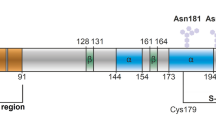Abstract
Pin1 protein is closely associated with the pathogenesis of cancers and Alzheimer’s disease (AD). Previously, we have shown the acid-induced denaturation of Pin1 was determined by means of fluorescence emission, synchronous fluorescence etc., indicating an intermediate state around chromophores in Pin1 at about 4.0. Molecular dynamics simulations for the wild type Pin1 and its mutants were performed to explore the role of pH in the conformation changes of Pin1 protein. Our present study shows that one protein domain (PPIase domain) is more sensitive than the other one (WW domain) in Pin1 protein, and also our study shows that the integrality of the two conserve tryptophan in one domain (WW) is important in response to low pH. We arrive at the last result with the analysis of the protein root mean square distance and the analysis of the radius of gyration. The analysis of protein solvent accessible surface area values have proven our previous experiment result that there is an intermediate state around tryptophan residues at about pH 4.0. Moreover, acidic states of the protein can break the alpha-helixes in Pin1, especially the alpha-helix α3 close to active sites; as a result, Pin1 loses most of its activity at low pH. The results help us to understand the role of pH in Pin1, provide us insights into the conformation change at the atomic-level and emphasize the important role of decreased pH in the pathogenesis of some Pin1-related diseases, and support the therapeutic approach for the related Pin1 diseases by targeting acidosis and modifying the intracellular pH gradients.








Similar content being viewed by others
Abbreviations
- Pin1:
-
peptidyl-prolyl cis-trans isomerase
- AD:
-
Alzheimer’s disease
- MD:
-
molecular dynamics
- WT:
-
wild type
- SASA:
-
solvent accessible surface area
- Aβ:
-
amyloid-β peptides
References
Liou YC, Zhou XZ, Lu KP (2011) Prolyl isomerase Pin1 as a molecular switch to determine the fate of phosphoproteins. Trends Biochem Sci 36:501–514
Wulf GM, Ryo A, Wulf GG, Lee SW, Niu T, Petkova V, Lu KP (2001) Pin1 is overexpressed in breast cancer and cooperates with Ras signaling in increasing the transcriptional activity of c-Jun towards cyclin D1. EMBO J 20:3459–3472
Ryo A, Nakamura M, Wulf G, Liou YC, Lu KP (2001) Pin1 regulates turnover and subcellular localization of β-catenin by inhibiting its interaction with APC. Nat Cell Biol 3:793–801
Ryo A, Suizu F, Yoshida Y, Perrem K, Liou YC, Wulf G, Rottapel R, Yamaoka S, Lu KP (2003) Regulation of NF-κB signaling by Pin1-dependent prolyl isomerization and ubiquitin-mediated proteolysis of p65/RelA. Mol Cell 12:1413–1426
Wulf GM, Liou YC, Ryo A, Lee SW, Lu KP (2002) Role of Pin1 in the regulation of p53 stability and p21 transactivation, and cell cycle checkpoints in response to DNA damage. J Biol Chem 277:47976–47979
Mantovani F, Tocco F, Girardini J, Smith P, Gasco M, Lu X, Crook T, Del Sal G (2007) The prolyl isomerase Pin1 orchestrates p53 acetylation and dissociation from the apoptosis inhibitor iASPP. Nat Struct Mol Biol 14:912–920
Lu PJ, Wulf G, Zhou XZ, Davies P, Lu KP (1999) The prolyl isomerase Pin1 restores the function of Alzheimer-associated phosphorylated tau protein. Nature 399:784–788
Pastorino L, Sun A, Lu PJ, Zhou XZ, Balastik M, Finn G, Wulf G, Lim J, Li SH, Li X, Xia W, Nicholson LK, Lu KP (2006) The prolyl isomerase Pin1 regulates amyloid precursor protein processing and amyloid-β production. Nature 440:528–534
Tiraboschi P, Hansen LA, Thal LJ, Corey-Bloom J (2004) The importance of neuritic plaques and tangles to the development and evolution of AD. Neurology 62:1984–1989
Luo Z, Wijeweera A, Oh Y, Liou YC, Melamed P (2010) Pin1 facilitates the phosphorylation-dependent ubiquitination of SF-1 to regulate gonadotropin β-subunit gene transcription. Mol Cell Biol 30:745–763
Reineke EL, Lam M, Liu Q, Liu Y, Stanya KJ, Chang KS, Meas AR, Kao HY (2008) Degradation of the tumor suppressor PML by Pin1 contributes to the cancer phenotype of breast cancer MDA-MB-231 cells. Mol Cell Biol 28:997–1006
Xu YX, Manley JL (2007) Pin1 modulates RNA polymerase II activity during the transcription cycle. Genes Dev 21:2950–2962
Wang JZ, Li SR, Li YL, Zhang YZ, Zhang T, Zhao CX, Yao CX, Du LF (2013) Could pin1 help us conquer essential hypertension at an earlier stage? A promising early-diagnostic biomarker and its therapeutic implications for the disease. Med Hypotheses 81:931–935
Wang JZ, Zhu WD, Xu ZX, Du WT, Zhang HY, Sun XW, Wang XH (2014) Pin1, endothelial nitric oxide synthase, and amyloid-β form a feedback signaling loop involved in the pathogenesis of Alzheimer’s disease, hypertension, and cerebral amyloid angiopathy. Med Hypotheses 82:145–150
Wang JZ, Lin T, Zhu GF, Du LF (2010) Stability of Pin1 as revealed by thermal and spectroscopic studies. J Mol Struct 975:310–316
Bom APDA, Freitas MS, Moreira FS, Ferraz D, Sanches D, Gomes AMO, Valente AP, Cordeiro Y, Silva JL (2010) The p53 core domain is a molten globule at low ph functional implications of a partially unfolded structure. J Biol Chem 285:2857–2866
Fang B, Wang D, Huang M, Yu G, Li H (2010) Hypothesis on the relationship between the change in intracellular ph and incidence of sporadic alzheimer’s disease or vascular dementia. Int J Neurosci 120:591–595
De Milito A, Canese R, Marino ML, Borghi M, Iero M, Villa A, Venturi G, Lozupone F, Iessi E, Logozzi M, Della Mian P, Santinami M, Rodolfo M, Podo F, Rivoltini L, Fais S (2010) pH-dependent antitumor activity of proton pump inhibitors against human melanoma is mediated by inhibition of tumor acidity. Int J Cancer 127:207–219
Hsu PP, Sabatini DM (2008) Cancer cell metabolism: Warburg and beyond. Cell 134:703–707
Pirchl M, Marksteiner J, Humpel C (2006) Effects of acidosis on brain capillary endothelial cells and cholinergic neurons: relevance to vascular dementia and Alzheimer’s disease. Neurol Res 28:657–664
Humpel C (2011) Chronic mild cerebrovascular dysfunction as a cause for Alzheimer’s disease? Exp Gerontol 46:225–232
Pirchl M, Humpel C (2009) Does acidosis in brain play a role in Alzheimer’s disease? Neuropsychiatry 23:187–192
Marksteiner J, Humpel C (2008) Beta-amyloid expression, release and extracellular deposition in aged rat brain slices. Mol Psychiatry 13:939–952
Wang JZ, Xi L, Zhu GF, Han YG, Luo Y, Wang M, Du LF (2012) The acidic pH-induced structural changes in Pin1 as revealed by spectral methodologies. Spectrochim Acta AMol Biomol Spectrosc 98:199–206
Bayer E, Goettsch S, Mueller JW, Griewel B, Guiberman E, Mayr LM, Bayer P (2003) Structural analysis of the mitotic regulator hPin1 in solution insights into domain architecture and substrate binding. J Biol Chem 278:26183–26193
Jacobs DM, Saxena K, Vogtherr M, Bernado P, Pons M, Fiebig KM (2003) Peptide binding induces large scale changes in inter-domain mobility in human Pin1. J Biol Chem 278:26174–26182
Chen L, Zhang JL, Zheng QC, Chu WT, Xue Q, Zhang HX, Sun CC (2013) Influence of C-terminal tail deletion on structure and stability of hyperthermophile Sulfolobus tokodaii RNase HI. J Mol Model 19:2647–2656
Karplus M, McCammon JA (2002) Molecular dynamics simulations of biomolecules. Nat Struct Biol 9:646–652
Morcos F, Chatterjee S, McClendon CL, Brenner PR, Peng JW, Lzaguirre JA (2010) Modeling conformational ensembles of slow functional motions in Pin1-WW. PLoS Comput Biol 6(12):e1001015
Luo Z, Ding J, Zhou Y (2007) Temperature-dependent folding pathways of Pin1 WW domain: an all-atom molecular dynamics simulation of a Gō model. Biophys J 93:2152–2161
Velazquez HA, Hamelberg D (2011) Conformational selection in the recognition of phosphorylated substrates by the catalytic domain of human Pin1. Biochemistry 50:9605–9615
Ranganathan R, Lu KP, Hunter T, Neol JP (1997) Structural and functional analysis of the mitotic rotamase pin1 suggests substrate recognition is phosphorylation dependent. Cell 89:875–886
Eswar N, Eramian D, Webb B, Shen MY, Sali A (2008) Protein structure modeling with MODELLER. Methods Mol Biol 426:145–159
Sali A, Blundell TL (1993) Comparative protein modeling by satisfaction of spatial restraints. J Mol Biol 234:779–815
Martı-Renom MA, Stuart AC, Fiser A, Sanchez R, Melo F, Sali A (2000) Comparative protein structure modeling of genes and genomes. Biophys Biomol Struct Rev 29:291–325
Fiser A, Do RK, Sali A (2000) Modeling of loops in protein structures. Protein Sci 9:1753–1773
Eswar N, Marti-Renom MA, Webb B, Madhusudhan MS, Eramian D, Shen M, Pieper U, Sali A (2006) Comparative protein structure modeling with MODELLER. Curr Prot Bioinformatics, Chap 5, Unit 5.6.
Humphrey W, Dalke A, Schulten K (1996) VMD: visual molecular dynamics. J Mol Graph 14:33–38
Rostkowski M, Olsson MH, Søndergaard CR, Jensen JH (2011) Graphical analysis of ph-dependent properties of proteins predicted using PROPKA. BMC Struct Biol 11:6
Phillips JC, Braun R, Wang W, Gumbart J, Tajkhorshid E (2005) Scalable molecular dynamics with NAMD. J Comput Chem 26:1781–1802
MacKerell AD, Feig M, Brooks CL (2004) Extending the treatment of backbone energetics in protein force fields: limitations of gas-phase quantum mechanics in reproducing protein conformational distributions in molecular dynamics simulations. J Comput Chem 25:1400–1415
MacKerell AD Jr, Bashford D, Bellott M, Dunbrack RL Jr, Evanseck JD, Field MJ, Fischer S, Gao J, Guo H, Ha S, Joseph-McCarthy D, Kuchnir L, Kuczera K, Lau FTK, Mattos C, Michnick S, Ngo T, Nguyen DT, Prodhom B, Reiher WE III, Roux B, Schlen-Krich M, Smith JC, Stote R, Straub J, Watanabe M, Wiorkiewicz-Kuczera J, Yin D, Karplus M (1998) All-atom empirical potential for molecular modeling and dynamics studies of proteins. J Phys Chem B 102:3586–3616
Jorgensen WL, Chandrasekhar J, Madura JD, Impey RW, Klein ML (1982) Comparison of simple potential functions for simulating liquid water. J Chem Phys 79:926–935
Berendsen HJC, Postma JPM, Van Gunsteren WF, DiNola A, Haak JR (1984) Molecular dynamics with coupling to an external bath. J Chem Phys 81:3684–3690
Essmann U, Perera L, Berkowitz ML, Darden T, Lee H, Pedersen LG (1995) A smooth particle mesh Ewald method. J Chem Phys 103:8577–8593
Ryckaert JP, Ciccotti G, Berendsen HJC (1977) Numerical integration of the cartesian equations of motion of a system with constraints: molecular dynamics of n-alkanes. J Comput Phys 23:327–341
Miyamoto S, Kollman PA (1992) SETTLE: An analytical version of the SHAKE and RATTLE algorithm for rigid water models. J Comput Chem 13:952–962
Martyna GJ, Tobias DJ, Klein ML (1994) Constant pressure molecular dynamics algorithms. J Chem Phys 101:4177–4189
Piana S, Lindorff-Larsen K, Shaw DE (2011) How robust are protein folding simulations with respect to force field parameterization? Biophys J 100:L47–L49
Acknowledgments
This work was financially supported by the National Key Technology R&D program of China (2009BAK61B04, 2006BAF07B01) and Science & Technology Foundation of Sichuan Province (2011JTD0026). NAMD and VMD were developed by the Theoretical Biophysics Group in the Beckman Institute for Advanced Science and Technology at the University of Illinois at Urbana-Champaign, USA.
Author information
Authors and Affiliations
Corresponding author
Rights and permissions
About this article
Cite this article
Wang, Y., Xi, L., Yao, J. et al. Role of pH in structural changes for Pin1 protein: an insight from molecular dynamics study. J Mol Model 20, 2376 (2014). https://doi.org/10.1007/s00894-014-2376-4
Received:
Accepted:
Published:
DOI: https://doi.org/10.1007/s00894-014-2376-4




